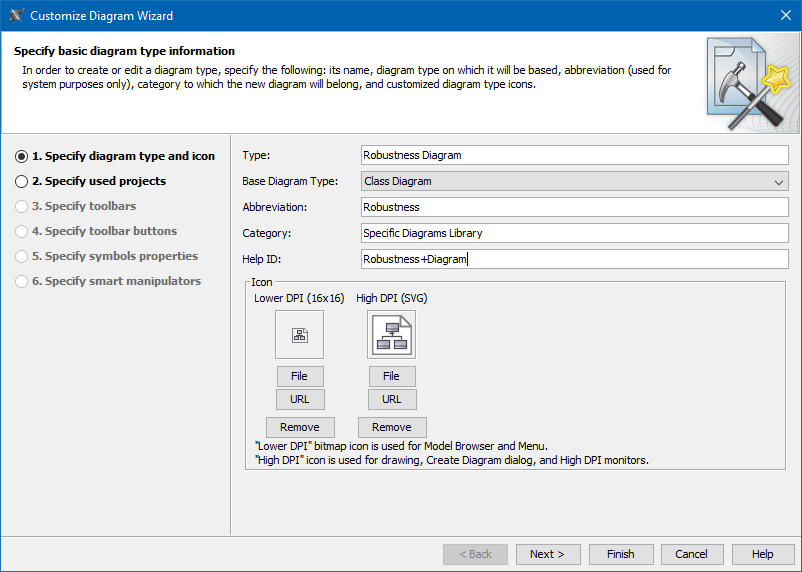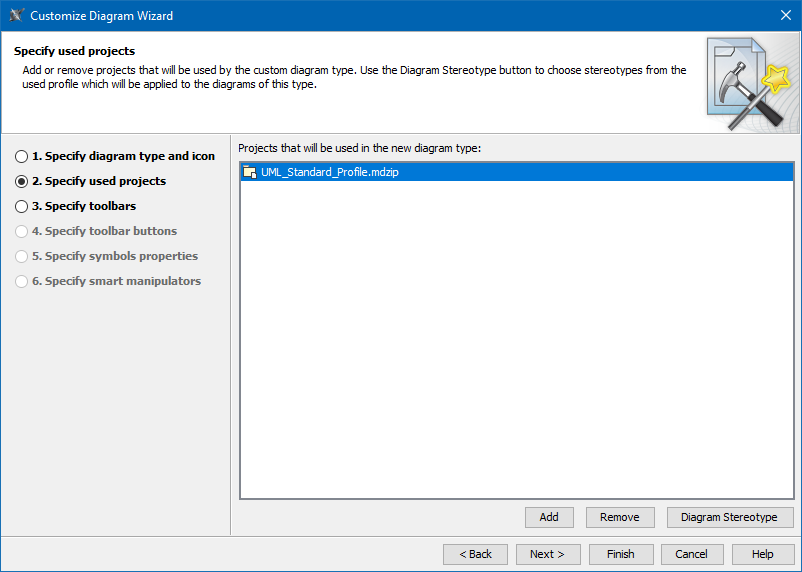Page History
The The Customize Diagram Wizard contains contains the following steps for creating a new diagram type or modifying a chosen one.
...
- Diagram type name (for example, Robustness Diagram).
- Base Diagram Type – standard UML diagram to be extended. All configurations, semantics, and other settings will be inherited from this diagram type.
- Abbreviation – a short form of the diagram name. It will be used in Diagram Frames header or Diagram shapes in Content diagrams.
- Category – creates your specific category in the the Diagrams menu menu or in the the Create Diagram command command list. You can store all your customized diagrams in this category. If you leave this field empty, the customized diagrams will be added to the the Custom Diagrams category category.
- Help ID – sets a specific Help ID to invoke help or documentation topics.
Icons – several icons for your custom diagram representation in MagicDraw GUI.
Note A custom diagram icon you upload from your file system must be in .gif, .jpg, .jpeg, .svg, .png., or .wmf file format.
Step 2: Specify used projects
...
Select the required used projects or local profiles. How to use a custom server profile see in in customizing diagram palette.
| Warning |
|---|
|
The custom diagram could use stereotyped elements. Profiles defining these stereotypes must be used by the custom diagram. The selected used projects or profiles load when a user creates a custom diagram in a project. You can choose a stereotype for the diagram by clicking the the Diagram Stereotype button.
...
button.
Step 3: Specify Toolbars
Every diagram differs by the elements used in them. In the Specify toolbars step, you can group standard or custom elements.
| Note |
|---|
Only toolbars compatible with the specific diagram type can be added. |
You can:
- Create your own custom diagram toolbar.
- Create your own toolbar, name it, and select an icon.
- Choose standard toolbars that will be visible in your diagram.
- Select existing toolbars inherited from the base diagram type.
- Arrange the order of toolbars by using "Up" and "Down" buttons.
- Select which toolbars will expand or collapse by default (use the Open check box).
...
Click Add and select standard UML elements or click Add and then New Button to create your own buttons to create customized or stereotyped elements.
| Note |
|---|
Only buttons compatible with the specific diagram type can be added to the toolbar. |
Customize the following properties when creating a new button:
...
Step 6: Specify Smart Manipulators
| Note |
|---|
Only elements that are available in the toolbars specified for the diagram being customized can be added to the smart manipulator of the element shape or path. |
Smart manipulators are special buttons that appear in the pop-up window when a shape or path is selected on a diagram.
...
Example of smart manipulator
You can configure the element or kind of relationship suggested when a custom shape or path is selected on a diagram.
...

